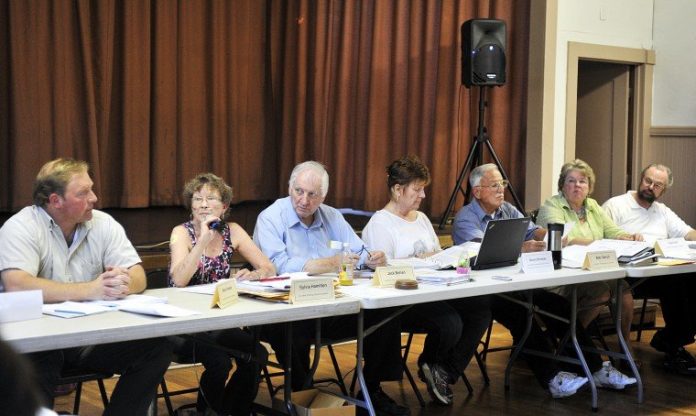
Nearly 200 South Santa Clara County residents attended a planning advisory meeting Tuesday night to voice an impassioned mix of concerns, opposition, support and questions regarding the proposed Cordoba Center mosque project which will be considered by the county’s planning commission Thursday.
County staff began the meeting at the Grange Hall in Morgan Hill by announcing they decided since last week to recommend the planning commission postpone the project due to the high volume of concerns submitted by the public. While last week the staff recommended the commission approve the project when it takes up the issue Thursday, on Tuesday they said they will recommend the body continue the decision in order to allow further studies of the soil permeability and groundwater depth on the 15-acre San Martin site where the South Valley Islamic Center plans to build the Cordoba Center.
But when the meeting turned to the public comment period, in which nearly 30 audience members used their allotted three minutes to voice their objections, support or suggestions for the project, the meeting quickly grew boisterous and, at times, nearly out of control.
Attendees shouted in argument from the audience against speakers whom they disagreed with, and applauded loudly with those they supported.
While Sal Akhter, SVIC member and Cordoba Center project manager, spoke as the last public commenter, the audience emitted a loud sustain of disapproval as he demonstrated the existing local presence of Muslim residents and activity in San Martin. Akhter was visibly and vocally upset at the reaction and many of the comments that preceded his, and directed his opinion to the audience rather than the committee.
“So much complaints and charges, I don’t where to begin,” said Akhter, who added he has lived in San Martin for 30 years. “We have followed every letter of the law, without a single request for a variance.”
Seated opponents of the project attempted to shout him down, particularly after he exceeded his allotted three-minute speaking limit and the committee allowed him to continue anyway.
“Time!” numerous audience members repeatedly and loudly shouted at the expiration of the clock. Dozens intermittently screamed angry responses to some of his comments.
Committee members made little effort to calm the crowd and allow commenters to speak without interruption.
The audience was standing-room only in the 186-capacity meeting hall, with people spilling out two doors on either side.
Most were against the project, citing the groundwater issue as well as possible impacts on traffic, noise, storm water runoff and flooding, and the Cordoba Center’s capacity to serve local needs in accordance with the county’s general plan. Some speakers even expressed unabashed fear of the Islamic community who plans to make the Cordoba Center their worship headquarters.
Several audience members displayed handmade posters alluding to various complaints about the project, labeling its developers a “special interest,” and asking who would be held liable if the groundwater becomes contaminated.
Situated on a 15-acre property on the 14000 block of Monterey Highway, just north of the intersection of California Avenue, the proposal includes two ranch-style structures – a prayer hall and a community center – as well as a cemetery and open space.
The staff’s lengthy report on the project determined that the Cordoba Center proposal would have no significant impact on any of the areas of concern cited by the public, including groundwater worries even though the staff concluded that a more updated study on that question is needed.
The first speaker following the county staff presentation was Michele Rasner of Gilroy, who prompted obscenities and boos from the crowd as she declared that she thinks the controversy is about religion and discrimination rather than groundwater or traffic related worries.
“Let us find similarities, not differences,” Rasner said.
When a female member of the SVIC addressed the committee next, grumbling moans emanated from the audience as she said, “This is about my civil rights and my children’s civil rights.”
Georgine Scott-Codiga, president of the Gilroy/Morgan Hill Patriots, said she and other residents are “afraid” of the project and they “don’t trust” county staff and county ordinances that will not prohibit construction of the mosque as long as the developer is in compliance.
Joy Schoming, a Gilroy resident, said she objected to the project’s name of Cordoba Center, which refers to an ancient Spanish city. To Schoming, the name also conjures up a Muslim community center formerly known as the Cordoba House that is under development in New York City, and which generated significant controversy when it was in the planning stages.
Schoming and others also worried about the possible noise impact from the facility, suggesting that calls for prayers at other mosques can be noisy.
County staff said no amplified music or speech would be permitted to emanate from the site, and it would be subject to existing noise ordinances.
Other residents at the meeting, who are not affiliated with the SVIC, spoke in support of the project, and argued that it will serve the local community through education efforts, developing a clean and aesthetically pleasing facility, and preserving a large portion of open space on the site.
One man prompted applause from some audience members with comments that speculated the Cordoba Center might be tied to violent offshoots of Islam that promote terrorism.
A number of speakers worried about the possibility that the SVIC’s membership might grow over the years, bringing larger crowds to the Cordoba Center and heightening the impact on traffic, parking, groundwater, noise and other areas of concern.
Current plans have between 30 and 80 people using the facility for daily and periodic religious services and events, plus three events a year that would bring up to 150 people.
In response to the concerns about growth at the facility, county staff said any changes to the site plan and capacity would require future approval.
One member of the SVIC, a Gilroy resident, who did not speak during the public comments said after the meeting that she was “embarrassed” by the audience’s behavior at Tuesday’s meeting.
“Civil discourse is always welcome, but we didn’t see that tonight,” said Shaesta Razaqi. “I’ve never been more embarrassed of my neighbors.”
Nuances of county planning codes discussed
Before and after the public comments, committee members had their own difficult questions for county staff.
In response to the staff’s interpretation of the “local serving” requirement for non-residential uses contained in the county general plan, committee member Sylvia Hamilton said she has never heard the code interpreted that way.
The ordinance, which says that such uses should serve the local community so as not to create undue impacts from outside visitors. Regarding the Cordoba Center project, staff said the intent of the ordinance is simply to ensure the project’s impact is at a minimum.
Plus, when it comes to religious institutions – which are not commonly applied for in San Martin – state and federal laws protecting freedom of religion and assembly trump the county’s land-use guidelines, and staff said the land-use codes cannot legally prohibit people from practicing their religion.
County planner Rob Eastwood added that the planning department has reviewed the local-serving requirement with county counsel, who advised them that it cannot “abridge First Amendment rights” of free speech and freedom of religion.
Eastwood added it would be “impossible” to enforce the local-serving guideline literally by requiring the facility to meet a certain threshold of local dedication.
The staff interpretation also relied on previous similar projects in San Martin that were approved, including a Buddhist prayer center on Church Avenue.
During his public comments, Akhter noted that the SVIC has already been meeting for prayers and religious services in San Martin for several years, at a member’s privately owned barn.
Committee member Bob Cerruti asked county staff a series of questions about the storm water and groundwater issues on the property, citing his own field research in preparation for Tuesday’s meeting, and discussions with longtime neighbors of the site who told him some of the county staff’s observations of the property are not accurate.
Those observations include the direction of runoff flow, which determines how the developer may design drainage control.
And Cerruti noted during heavily rainy years, these neighbors have seen groundwater “bubbling up” out of the ground from depths much shallower than those previous groundwater studies have identified.
A groundwater study conducted earlier this year by the consultant Geoconsultants found that the groundwater basin starts between 17 and 37 feet below the topsoil, depending on the elevation on the property, which slopes uphill from Monterey Road to the north and west.
Staff said the additional groundwater studies, which prompted their last-minute decision to recommend delaying approval, would likely be completed before the planning commission’s September meeting. Santa Clara County planning manager Kirk Gerard said those tests will examine the site of a proposed drainage field on the property, as well as that of a reserve leach field elsewhere on the same site to ensure the soil will accommodate expected water runoff and not contaminate the groundwater.
“With the great deal of input we have received, we want to make sure we can fully support the project,” and fully analyze the project’s possible effect on the groundwater basin, Gerard said.














